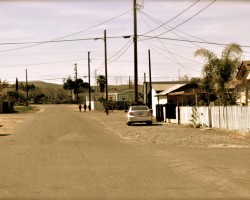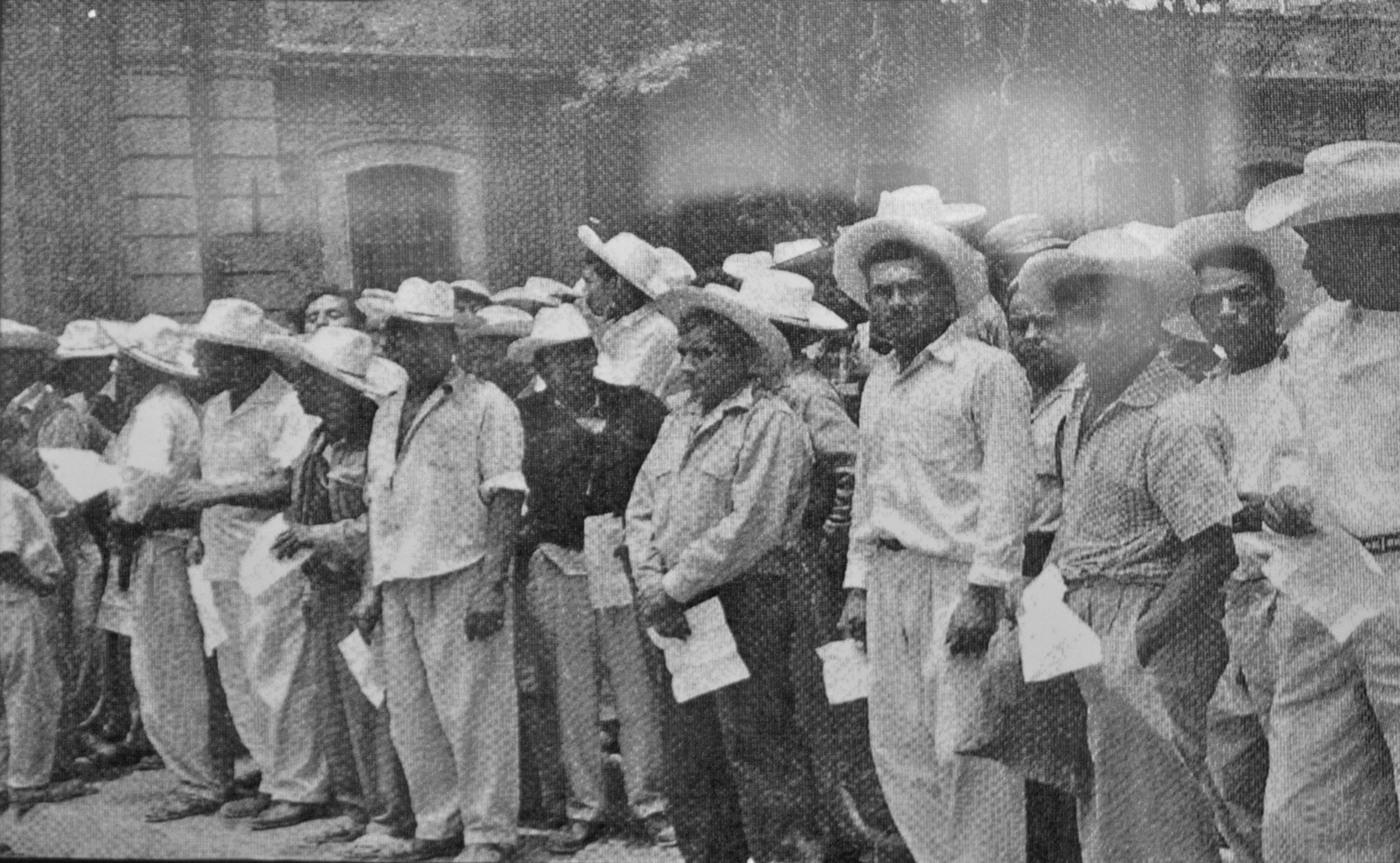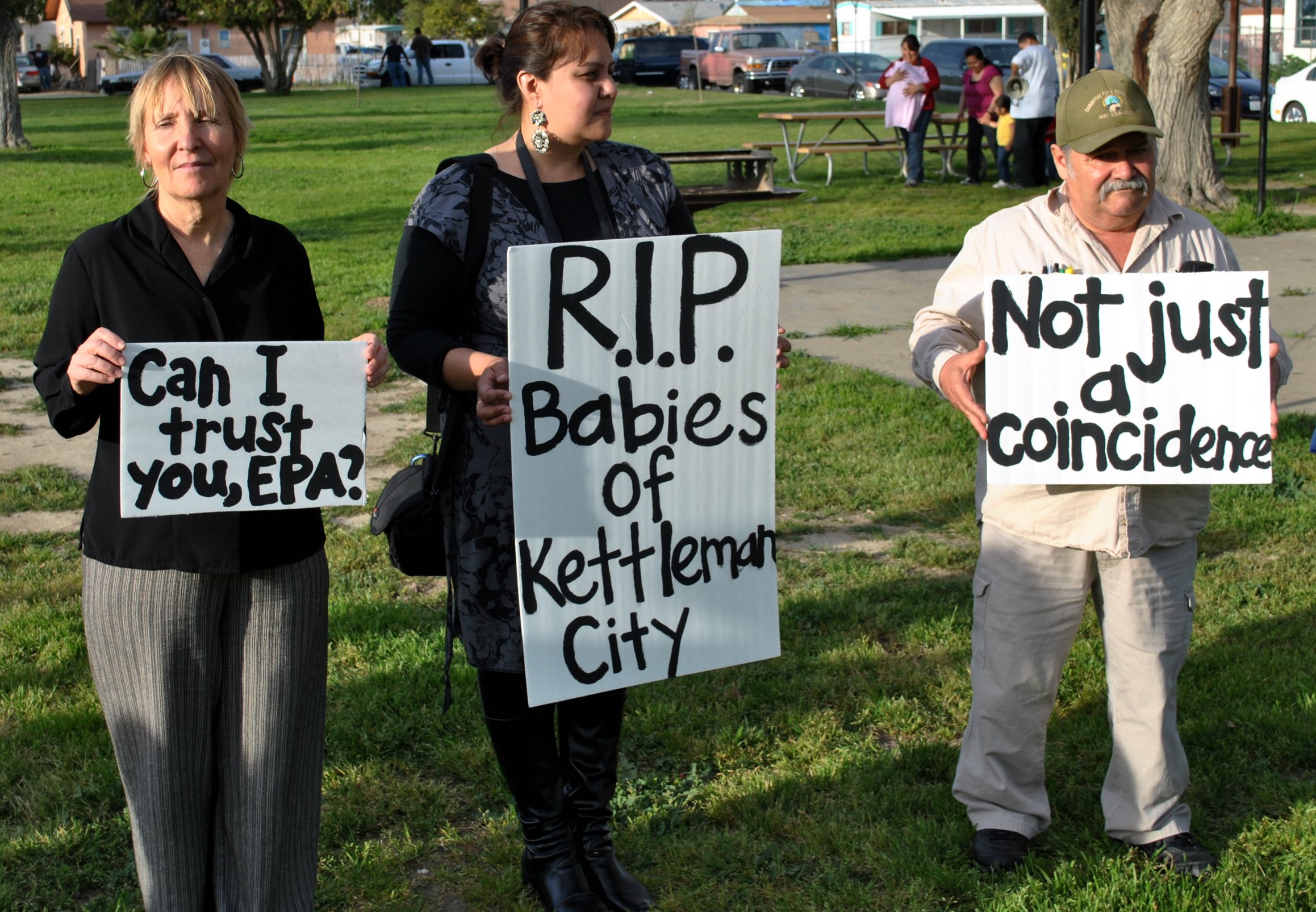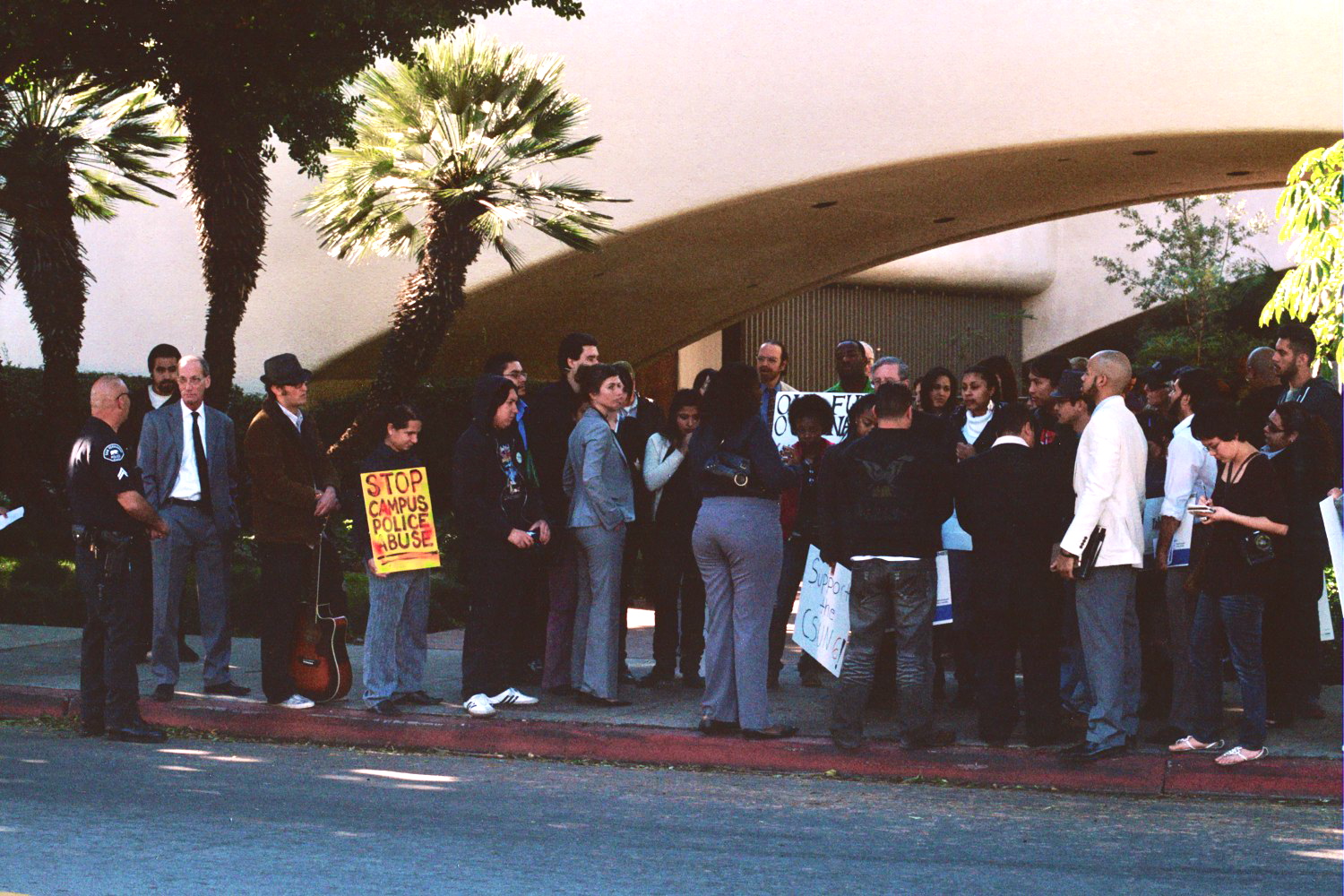Residents of Kettleman City are fighting the continued dumping of toxic waste in the city, citing incidents of birth defects and infant deaths
Watch video: here.
RACHEL COSTAHAUDE
JULISSA REYES
EL NUEVO SOL
The air is thick with the stench of chemicals from the agricultural fields surrounding the city. Small, cluttered houses line the sidewalk-less streets. An abandoned swing set rusts in a front yard.
The city’s only park is quiet. Six men wearing cream-colored cowboy hats play a game of cards at a picnic table. At another picnic table, Anna Martinez of Greenaction and Maria Saucedo, the mother of Ashley who died at 10 months due to birth defects, place drip protectors on 120 candles in preparation for the vigil, set to take place in an hour.
Saucedo wears a yellow T-shirt with a picture of Ashley and the words “Madre en la lucha” or “Mother in the struggle” printed on it. Saucedo’s other daughter, 3-year-old Citlaly, stares at the three caged doves that are to be released during the vigil. When the birds get startled, Citlaly jumps in fear, then snickers with relief. Members of the community begin to trickle in.
Not much has changed since 1988, at this park, which takes up a small block between General Petroleum and Standard Oil avenues. Back then, dogs wrestled in the grass just as they do today. Children played cops and robbers. Groups of local high school kids hung out with their friends. One change: the old brick drinking fountain once used by community members now is ignored.
Another change since then: the sense of unity that has developed within the community. Countless community meetings in support of the mothers who have given birth to children with a cleft lip or palate or other deformities, and protests against Chemical Waste Management, whose toxic waste caused such defects many say, have taken place in this same park. Today, March 15, the community is gathering in remembrance.
Bradley Angel, co-founder of Greenaction, has been fighting for Kettleman City since the very beginning. As a member of Greenpeace Angel discovered in 1988, that Chemical Waste Management was applying for a permit for a hazardous-waste incinerator that would allow the hazardous-waste dump, located on the outskirt of Kettleman City, to dispose of even more toxic waste. In January 2010, this plan was finally abandoned by Chemical Waste Management due to community concerns and uncertainty about the levels of radioactive ingredients in these materials.
Still, the hazardous-waste dump is the largest toxic waste dump west of Alabama. In 2009, more than 350,000 tons of toxic waste were dumped at the Kettleman City site, including thousands of pounds of asbestos, pesticides, caustics, petroleum and over 11,000 tons of polychlorinated biphenyls, PCBs. In January, a Kings County Superior Court decision permitted Chemical Waste Management to expand the Kettleman City toxic waste dump.
According to the U.S. Environmental Protection Agency, PCBs are known to cause cancer and affect the immune, nervous, reproductive and endocrine systems. In 1979, said Angel, the production of PCBs was banned in the U.S. “because they’re so damn toxic. But Kettleman City is one of the few places they’re sent [to be disposed of].” Indeed, Chemical Waste Management has been accepting PCBs under an expired permit for the past 12 years. They blame the EPA for delays in reevaluating the permit, which should only take a couple months, according to Anna Martinez of Greenaction.
*****
Being home to one of the most highly toxic hazardous waste dumps in California is just one of the curses Kettleman City must cope with. Farm workers, who are regularly exposed to harmful pesticides, make up the majority of the workforce in Kettleman City. The air carries those pesticides from the fields to
contaminate the rest of the community.
Additionally, it was discovered in 2008 that the city’s two public wells contain levels of naturally occurring arsenic that exceed CalEPA’s Maximum Contaminant Level, MCL, by 63 percent and levels of benzene that exceed the MCL by up to 120 percent. Arsenic and benzene levels this high are known to cause birth defects, according to CalEPA.
Greenaction was founded in 1997, and on January 1, 1998, it made Kettleman City its first campaign and highest priority. In an effort to understand just how toxic these elements were to the community, Greenaction conducted a survey of the community members in 2008. Martinez said she and other Greenaction members spent weeks “going door to door and sitting down with folks and asking them personal questions.”
Angel said, “We did not expect to find what we found. We expected to find asthma, which we found. We expected to find cancer, which we found.” But they also found several cases of birth defects.
Maura Alatorre, 27, the mother of Emmanuel who was born with a cleft lip, part of his nose missing and an enlarged head, remembers when the surveys were conducted. “She [Martinez] was doing some surveys and I don’t know what, and she sees my son and is surprised. ‘You also have a son like that?’ And then she starts to talk about the other families. I didn’t know. Even though it’s a small community, people still don’t know each other.”
According to a story published by CaliforniaWatch.org, only one birth defect was detected between 1988 and 2007. However, between 2007 and 2010, at least 11 babies were born with serious defects. Three of the babies died and a fourth was stillborn. According to March of Dimes, the 4.3 million babies born each year in the United States, 120,000 babies are born with serious defects; or approximately 2.7 percent. Kettleman City’s population of less than 2,000 was high enough with birth defects to raise suspicions among community members.
Several investigations have been done to find out what exactly was causing the birth defects but a direct cause has yet to be found. Potential causes include genetics and behavior of the mothers during pregnancy, both of which have been ruled out; pollutants from pesticides; diesel emissions from the hundreds of trucks that drive through the city each day; contaminated water; or the toxic waste dump.
Saucedo, now a Greenaction member, said, “From 2007 to 2009, they [Waste Management] tripled the payment they’d make to the city. That means that from 2007 to 2009, they disposed of more contaminants than usual. So, I’ve been here 17 years, living in Kettleman City, and nothing like this [the birth defects] had ever happened. Why from 2007 to 2009, did all this happen?”
“Everyone wants to know what’s going on,” Martinez said. “A lot of folks were scared. They didn’t want to leave their houses.” Some of the unaffected community members started rumors that the parents were alcoholics and drug addicts.
Alatorre said, “I ran into a woman who was unaware of my son’s birth defects. She started to say that mothers do not have anything to do. She said, ‘I think these mothers used to work in the field and their husbands did drugs and that is why their children were born like that.’
“And I told her, ‘You know something, I do not use drugs, never used drugs, I do not drink or smoke, and was never close to people who smoke. My husband does not do anything like that. My husband works in the field but he takes care of himself. Every time he gets home he changes his clothes because he wears overalls when he sprays chemicals. He takes off his shoes outside and does not enter the house like that. He also washes his clothes separately. We take care of ourselves so I do not think what you said about drugs and other things have affected us.’
“And she [the woman] got surprised and said, ‘Did you have a son like that?’ and I told her, ‘Yes!’ So people got surprised that in my case that did not apply to me. ‘I cannot tell you about other families, but if they say that does not apply to them, I also believe them. I only can tell you from my case,’ I responded to her.”
*****
Maricela Mares-Alatorre, member of People for Clean Air and Water and a 32-year Kettleman City resident, said of the mothers, “It’s like a club you don’t want to join. There’s solidarity among them because they know what they’re suffering; they know the pain.”
Alatorre remembered that after giving birth to Emmanuel, “I’d say, ‘God they are going to laugh at my son. They are going to look at him with pity. They are going to point at him. Other children are going to tease him.’
“I would always show him to people. I would see how people would, upon seeing my son, try to hide it. They would just stare, so I would get him closer. So they would look at me, seeing that I wasn’t embarrassed of him. If they would say, ‘You have the option of putting him up for adoption,’ I’d never do it. Having that option, to me is not an option.”
Alatorre said that before the contamination in the water was discovered, “if I’d make chicken soup, all the water would be from the tap. Beans, everything. I wouldn’t drink it directly because it has a bad taste. But I’d use it for food and that food we’d eat every day.”
In the park, a man walks up and rests his cane on the brick drinking fountain. He turns the faucet on and washes his hands in the contaminated water but refrains from drinking it. If they can afford it, members of the community now buy bottled water for .75 cents a gallon to use for drinking and cooking. Alatorre said of the contaminated water, “I don’t use it. Well just to shower, to wash the dishes and things but not even to wash the vegetables.”
Guadalupe Mandujano, 53, a resident of nearby Avenal and a mother of four, works at a local restaurant. “Many times people don’t have money to go buy water,” she said. “People find it easy to use the tap water to cook with. They think, ‘I’ll just boil it and it will be okay,’ but no.”
A patron of Mandujano’s restaurant and 27-year resident of Kettleman City, Michelle Magallan, said her mother worked in the fields and there have been no health problems in her family. Magallan, who uses a filtration system for the water in her house, said she thinks the birth defects have to do with genetics and the behavior of the mothers more than the toxic waste facility, pesticides, diesel fumes or the contaminated water. Mandujano responded by shouting, “Well that’s why! Because they have a filter.”
Mares-Alatorre has given birth to two children, one of whom she was pregnant with during the initial discoveries of birth defects. Although she had no prenatal care and no extra protection, neither of her children were affected. California Department of Public Health tried to blame the mothers but “I know in my heart that it wasn’t something the moms did negligently,” said Mares-Alatorre.
*****
Slowly, community members have begun to stand behind the mothers in the fight against Chemical Waste Management. Mares-Alatorre has been involved in environmental justice since high school and recalls being told by the mothers with affected children, “Oh, I used to see you when you used to always invite me to meetings. We thought you were crazy and you were always protesting something. I never wanted to go. I thought it wasn’t affecting me and then this happened to my child and now I know it’s important that we have to go out there and we have to speak out.” She added, “Sometimes it takes a catastrophic event to get someone involved.”
The problem lies in the fact that only a small number of families have had to deal with this catastrophic event. Alatorre said, “I do not want more children to be born with birth defects. The way our community has been involved is because they already had a family member that was born with birth defects. And that is the only way they get involved. If not, they would not. I am not saying to have more children with birth defects so the community gets involved because that is not what I am wishing for! But I would not know what to do in our community to have more support. The only thing I could think of is to pray for God’s help and continue surveying people on what they think and ask them for their support. Maybe after we keep on insisting so many times, there would be support and change. Because if the community gets united, that is the only way people will be heard; if we are only a few, they will not listen to us.”
The owner of La Abejita, a local party store that carries items from batteries to marshmallows to tree-shaped air fresheners, is a resident of Avenal but has owned his store in Kettleman City for six years. He said of Chemical Waste Management, “I think we could triumph over a giant like that if and only if we hit them all at the same time and in a place where they can be knocked over. But if it’s only the women who are affected with their babies, and a few activists from the city, I think not. It should be the whole population or else it will be just noise being made.”
However, he added, “I haven’t gotten involved, whether it’s because of lack of time or my own negligence, but no. Because it’s a giant, not much can be done.”
Pastor Lucas, a small man in an over-sized suit, of the Bethel Temple in Kettleman City, said of the mothers, “A lot of times they have come for guidance and prayer.” As a pastor in Kettleman City for eight years, he recognizes that “a lot of people are hurting but there’s not much you can do.” He gives the affected families all the prayer and support that he can offer.
Members of Greenaction find that one obstacle to their work lies in informing every member of the community. Martinez said, “The new people, some of them are seasonal workers, and we get our message out there but sometimes either they don’t know how to read or they just choose not to read it.” She added that they tend to take the viewpoint that, “‘Oh, we’re just there for a little bit so it doesn’t affect us.’”
When the investigations began, a group of local children ages 12 to 18 formed an organization called Kids Protecting Our Planet, or KPOP. The group hosts fundraisers and other community events. “We try to engage the youth as much as we can,” said Martinez. Although the age limit was set at 18, some of the KPOP members are now in their 20s and act as mentors for the younger members. Gladys Alatorre [not related to Maura Alatorre] said that she stays involved with KPOP “so we have a better place to live.” She is planning on raising a family in Kettleman City and doesn’t want to have to worry about contamination or birth defects for her children.
Not much has changed in the daily lives of Kettleman City residents since the discovery of the cluster of birth defects in 2008. Maura Alatorre said, “The only thing that I see that’s changed is uniting a little bit more. At first the community would have that attitude that we, the mothers, had no business doing what we were doing, that we were just making a fuss. But it wasn’t that. No. Whatever the case, because of all this we became aware of the water or else everything would be the same.”
Abandoning the city is not an option for many members of the community, most of whom have lived in Kettleman City for their entire lives. Saucedo said, “I can leave, say, ‘You know what? I’ll go live in Los Angeles or another place that won’t be contaminated,’ but what’s going to happen to the rest of the people?” Recognizing that there is no way to turn back time and bring back her daughter, she added, “I’m fighting for the rest of the people, not just for me. That’s my fight.”

Kettleman City has the highest Latino population in Kings County and also some of the worst pollution in the county.
*****
It’s 6 p.m. on the evening of March 15 and the vigil is under way. About 70 people have gathered in the park; community members, environmental activists and media, among others. Fresno’s Univision Channel 21 films as Saucedo, Martinez, Alatorre, Angel, Mares-Alatorre, Pastor Lucas and several other community members, activists and lawyers take turns showing their appreciation to the audience for their involvement and support.
Signs emblazoned with the phrases: “Can I trust you, EPA?” “R.I.P. babies of Kettleman City,” “Not just a coincidence,” “Remember us children,” “Do we matter?” are held by members of the crowd.
Members of the Brown Berets, a social justice organization from Fresno, hold a painted banner that depicts Kettleman City with the toxic waste dump spewing toxins into the air, not far from the park where they are gathered now. The sign reads, “Environmental Justice Now,” in English and Spanish. Ruben of the Brown Berets said, “People’s health comes before profit and we recognize that that doesn’t always happen in our state or nation.”
Not only does this vigil serve as a remembrance for the babies who died and a recognition of those still alive, it also acts as a galvanizing force within the community in the fight against Chemical Waste Management.
Ingrid Brostrom, an attorney representing Greenaction and People for Clean Air and Water, announced plans to appeal the Kings County Superior Court’s January decision to permit Chemical Waste Management to expand the Kettleman City toxic waste dump. Brostrom is also citing discrimination in their case, saying, “Kettleman City has the highest Latino population in Kings County and also bears the highest brunt of pollution in the county.”
In response to the appeal, Lily Quiroa of Chemical Waste Management said, “Kings County Superior Court conducted a very thorough review of the CEQA [California Environmental Quality Act] process including holding four hearings prior to its ruling. In its findings, the Superior Court Judge found that that EIR [Environmental Impact Report] complies with all provisions of CEQA, including the analysis of potential health impacts and the evaluation of cumulative impacts. We are confident this will hold true again.”
To keep from feeling completely cast aside by government agencies, Kettleman City community members say they must make their voices heard while suppressing any sense of hopelessness. Alatorre said, “The only thing that I do for my community is to attend meetings and be present every time people from agencies like EPA, the Health Department, come to the meetings. I speak on behalf of my community. And I also give out interviews, anything that helps get our voices heard. Sometimes I am very nervous speaking in front of cameras, not knowing what to say, but I do it to make a change and help my community out.”
Saucedo said, “Something has to get solved. And if 10 mothers are here fighting and in the end only two or three mothers are left, we are not stopping. We won’t move. And if we have to go talk to the radio, to the news, I don’t care. I’ll go because my pain, who will take it from me? No one will take it from me.”
[Several of the interviews were conducted in Spanish and translated to English]Tags: environmental justice EPA Greenaction Julissa Reyes Kettleman City Rachel Costahaude















